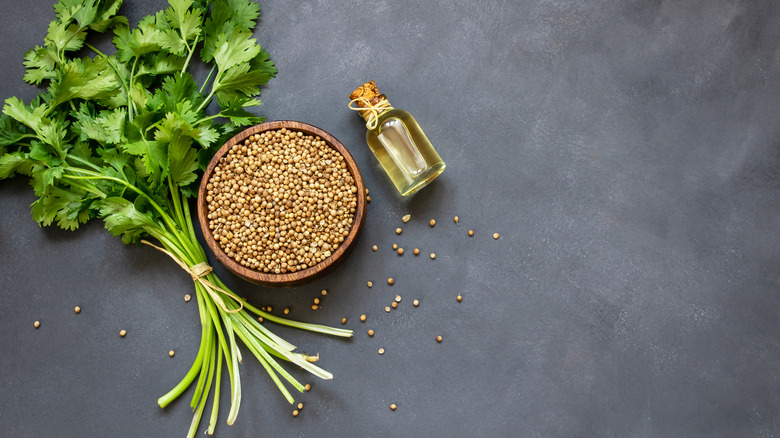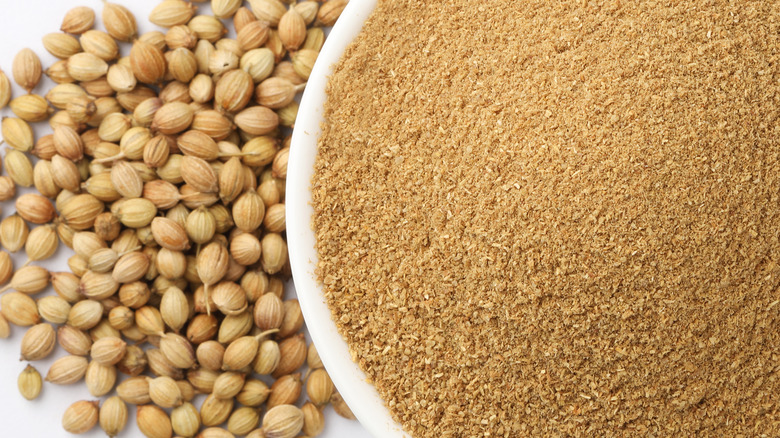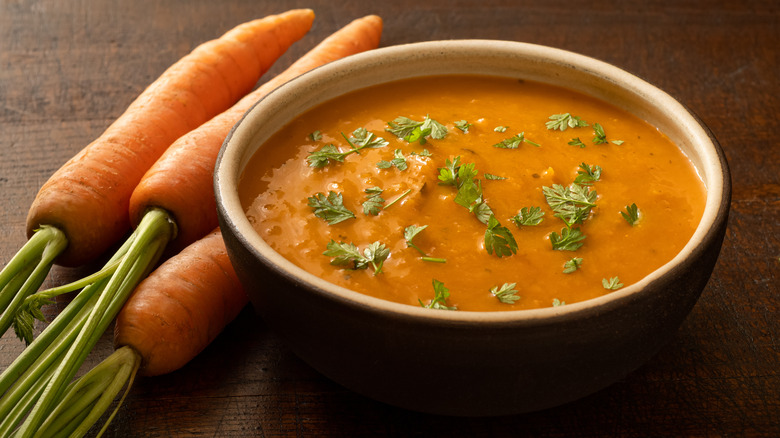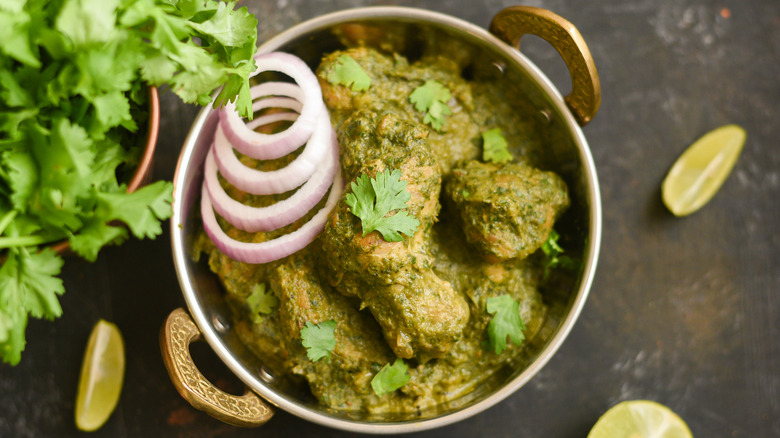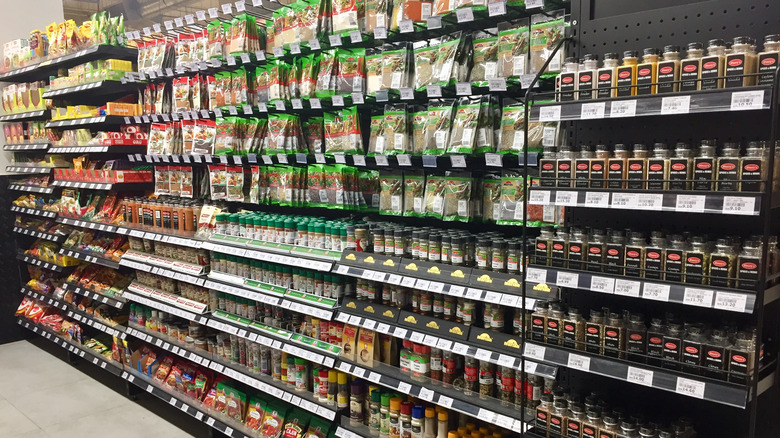What Is Coriander And What Does It Taste Like?
You've probably stopped and stared at the array of spices in your grocery store a thousand times. And you've likely seen coriander every single time. So, what exactly is this magical spice? Coriander (Coriandrum sativum) is a 100% edible aromatic plant used in international dishes all around the world. It's grown in regions in southern Europe, North Africa, and southwestern Asia (via Spiceography).
Culinary experts have calculated that the delicate, leafy plant was first used as a spice around 5000 B.C. Coriander not only has a full-bodied taste, but a rich history as well. It's believed to be one of the oldest herbs on record, with symbolic references to the spice in the Old Testament of the Bible as well as ancient Sanskrit writings (via Faith & Culture). The seeds were found in the tomb of Egyptian king Tut, according to Nutritional Geography, and in the times of the Roman Empire it was seen as a cure for snake bites and other ailments. The colonists of Massachusetts also grew it upon arriving in America, per The Spruce Eats, making coriander a truly international herb. Let's explore this beautiful, multipurpose spice, shall we?
What is coriander?
In its most basic definition, coriander is the term used to describe the dried seeds of the cilantro plant. Wait, what?! Let's back up a bit. The coriander plant's leaves are widely known as cilantro, which is actually the Spanish word for coriander. See, things are starting to make more sense now. And as we all know, cilantro is an herb that people either love and appreciate or absolutely hate (more on that in a bit). The seeds of the coriander plant are often dried and ground into a spice that's used in many European, Asian, Latin, and Indian dishes, according to MasterClass. To make things even more confusing, the leaves are known as cilantro in the U.S., while they are called coriander in other countries.
Though it might be hard at first to tell what's what, this herb is super good for you! Coriander has several well-known health benefits and medicinal properties, including the ability to lower blood sugar, provide immunity-boosting antioxidants, protect brain and heart health, strengthen and clear skin, promote good digestion, and soothe symptoms of IBS (via Healthline). An ingredient that's both delicious and nutritious? That's a win-win!
What does coriander taste like?
Coriander seeds possess a bright, warm, floral, lemony flavor and aroma that's released into the surrounding air when lightly toasted. Mmm! Similarly, according to MasterClass, fresh coriander should have a refreshing, tart, and citrusy taste. The subtly nutty flavor of coriander is often used in spice blends, as it helps to harmonize even the most complex flavors. You can commonly find coriander mixed into Egyptian dukkah and Indian garam masala; it's also often combined with cumin, cinnamon, and fennel.
Coriander adds a nice, deep flavor to Thai curry pastes, and makes frequent appearances in Vietnamese pho and spicy Chinese stir fries. Possibly one of the most classic recipes that calls for coriander is homemade dill pickles. Cucumbers are soaked in a brine made with a mixture of water, vinegar, salt, coriander seed, dill seed, and red pepper flakes.
On the other hand, coriander's fraternal twin cilantro usually sports a strong, perfume-y taste and is often used as a garnish in anything from tacos to banh mi. However, sadly, some people have an adverse gene that makes cilantro taste like soap, according to 23andMe. Sometimes, disliking a food really is built into our DNA.
How do you cook with coriander?
There are tons of fabulous dishes that call for coriander in their recipes: rice, potatoes, slaw, sauces, soups, and even smoothies! Ground coriander is often blended with cumin to create an even bolder flavor that makes the taste buds dance. Since coriander and cumin compliment each other so well, they are often used as substitutes for one another. According to Thrive Cuisine, coriander also resembles a more savory cardamom with bright notes of lemon pepper. It's a common ingredient in curry dishes and baked goods, as it provides a nice balance against sugars and sweeter spices. It even has the unique ability to make baked goods containing blueberries taste extra blueberry-like.
Whole coriander seeds are often used in pickling and brining to bring forth a hint of warmth. The seeds are usually lightly toasted to release their captivating fragrance before being added to dishes or ground into a powder. The flavor of this lively, versatile spice deepens the longer it's cooked.
Where can you buy coriander?
Thankfully, cilantro and coriander can be easily found in most grocery stores, usually in the general spice and seasonings aisles. In some stores, you can pick it up in the international aisle near the Mexican foods and ingredients, Spiceography notes. Both forms of coriander are often available side by side; you can either grab a jar of the whole seeds or opt for the pre-ground, dried spice, whichever you prefer.
As with most products, you're likely to find a range of prices of coriander, depending on the form, time of year, brand, quantity per unit, general quality, and other value-determining factors. For example, jars of dried cilantro and coriander typically cost between $2 and $15, depending on how artisanal you want to get. However, if you want to grow cilantro from scratch and plant it in your own home garden or on a sunny windowsill, seeds are usually a bit cheaper, between $2 and $4 (via How Much Is It).
Love it or hate it, coriander is here to stay.
